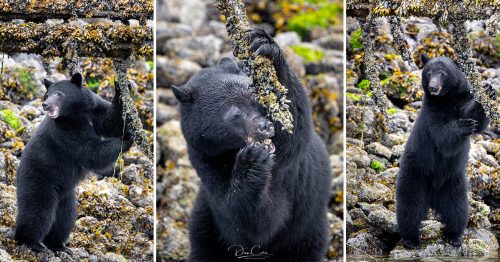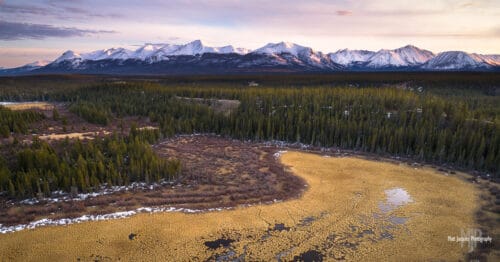I recently set out to bolster my collection of fox photos and to get the kind of intimate images I wanted, I used a couple of pieces of relatively cheap equipment that totally transformed my chances of getting the shot.
Wildlife photography is always a huge challenge because you have no control over your subject and the environment in which they are living. It’ll often take days for me to get the shots I’m after, so I’ll always take any opportunity to give myself an advantage – apart from baiting the animals of course! That is a huge no no in my book.
These two tools I have been using have helped me get some incredible wildlife images that stand out from the crowd, and they can help you do the same thing!
A Trail Camera
The first item is a trail camera. These small, portable cameras are motion activated and they can be set to collect either still images of short video clips. They are extremely useful for research purposes!

With these foxes I cam across a possible den site on a walk one evening, but it wasn’t immediately clear to me if it was still in use. Given the time of year, I had been looking for a den with newly born fox kits so I deployed a trail camera overlooking one of the entrances to the den, and left it for a few days.
Great success! Exactly what I had been looking for:
Not only did the trail camera confirm to me that it was in use and that there were three cute kits in the den, it also allowed me to figure out their daily routine by using the time stamps on the bottom of the video. A quick look at the stamps from 100 or so videos, and I had a pretty clear indication of their morning and evening routines which would then allow me to make a schedule for my own shooting at the den site.
The other piece of information I was able to gleam from the video was the direction that the kit’s mother usually left the den area in. At this young age the kits stay relatively close to the den while to the parents go off to get food. After watching her movements, it was clear that she almost never left the den headed in the area opposite the camera position. This would make it a perfect spot for me to go and hide to get my photos. If I had positioned myself on one of her regularly used paths, it would have really disrupted her movements and potentially scared them into the den.
Really understanding your wildlife subjects is key to getting great images, and a trail camera can help you do just that!

The trail camera that I use is an old Browning camera that is no longer made, but I highly recommend that brand and their other cameras. They make a bewilderingly large array of cameras with different specifications, but I prefer the ones with a small LCD screen in them as this gives you preview of the shot and allows you to accurately point it at something like a fox den, as I did. In the models with no screen, you’re really flying blind.
The LensCoat LensHide



This cool piece of kit is a highly portable photography hide that can easily be clipped to the outside of your camera bag when hiking to your location. It is designed to be thrown over the top of you and your tripod, but there’s also plenty of room for a foldable chair if you think you will be waiting a long time. The LensHide has a zippered mesh screen to allow you to see your surroundings, and a hole in the front to poke your lens through.
Different camouflage patterns are available, as well as lightweight and waterproof versions of all versions. In the summer I prefer the lightweight Realtree Max-4 version, but I have a waterproof snow camo version for the winter. Not only does the waterproof one keep the rain and snow out, but it also keeps the heat in! As a bonus, these covers also keep the bugs off in the summer.
For these fox photos I actually didn’t use a tripod at all. Instead I simply lay in the woodland moss and got under the LensHide. This allowed me to easily adjust my position when the foxes weren’t around, or were looking the other way.
With some animals, from a distance you can be easily hidden by the LensHide. To be clear, with these photos the foxes could obviously see something was there and they often looked at me, but after some time getting used it they didn’t perceive this big green lump as a threat. Whether they see you or not isn’t the important thing, it’s whether they perceive a threat that will dictate whether they stick around for a photo or not. In this regard, the LensCoat LensHide is definitely a winner!
What’s also nice about it is that it folds up into it’s own pocket and can then be strapped to the outside of your backpack. I know there are many kinds of larger photo blinds on the market, but they weigh several kilograms so they aren’t easy to carry into the field along with an already heavy camera bag. If you want to read more about this portable photo blind solution, check out my LensCoat LensHide review.
Conclusions
For avid wildlife photographers I think these are two items that should be on your wish list! When you consider the money that people invest into telephoto lenses and fast cameras for this kind of photography, the price of these items is very low, but they will definitely help!
It’s wonderful to be able to use a trail camera to understand your subject a little more, and then use a portable hide to watch their world more closely.














Thank-you for sharing these beauty-images! Fox are so elusive but you really got some intimate photos. It appears, from the work shown that they do not even know you’re there, … impressive!
Thanks for your kind words Frances 🙂
Wow, I’ve never seen shots so clear and up close before! I set up some of my own cameras but I focus mostly on big game. Keep up the great work, I want to see more! So far I’ve picked up a few photos, I recently switched to a new attractant and it has been working pretty good. https://www.critterlick.com/
Do you really find it necessary to bait the animals for your shots?
Fantastic shots! Foxes are truly one of the great gifts of nature. I’ve been wanting to photograph foxes for years but could never locate any. Then mid-April 2019 someone ran into my office and said there was a vixen with 6 kits outside our office kitchen window living under the building next door 100 feet away! Lucky me! I spent the next 5 months photographing them daily (I have a very understanding boss!).Ended up with a massive collection of photos and consider myself extraordinarily lucky. Hoping they return this spring!
Wow! What a stroke of luck Ernie. I shall keep my fingers crossed that they come back for you. Thanks for the kind words.
Hi Dan, I live in the Pacific Northwest and wondering about the lightweight vs. waterproof versions of this. I also travel. If you dress for rain and/or cold, would you be fine underneath the lightweight. Thinking of spring or fall. Thanks!